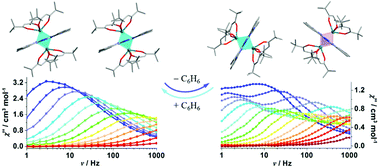Phthalocyanine supported dinuclear LnIII complexes: the solvent-induced change of magnetic properties in dysprosium(iii) analogues†
Abstract
Three dinuclear lanthanide complexes, [Ln2(thd)4Pc]·2C6H6 (Hthd = 2,2,6,6-tetramethylheptanedione, Ln = Sm (1), Tb (2), Dy (3)), have been synthesized based on phthalocyanine (Pc). They can be reversibly transformed into [Ln2(thd)4Pc] (Ln = Sm (1′), Tb (2′), Dy (3′)) via desolvation and resolvation of the lattice benzene molecules. This change generates dramatic influences on the structural and magnetic properties of the dysprosium analogue. In complex 3, one crystallographically independent metal center is observed, and it exhibits a single relaxation process of magnetization with an energy barrier of 55.7 K. Upon desolvation, the resulting complex 3′ contains two types of metal centers, and shows the field-induced single-molecule magnetic behavior with two thermally activated magnetic relaxation processes. The anisotropy barriers for 3′ are as high as 63.3 K and 109.6 K, respectively. This work confirms that the solvated molecules can finely tune the magnetic relaxation mechanisms.

- This article is part of the themed collection: Dalton Transactions Inorganic Symposia


 Please wait while we load your content...
Please wait while we load your content...